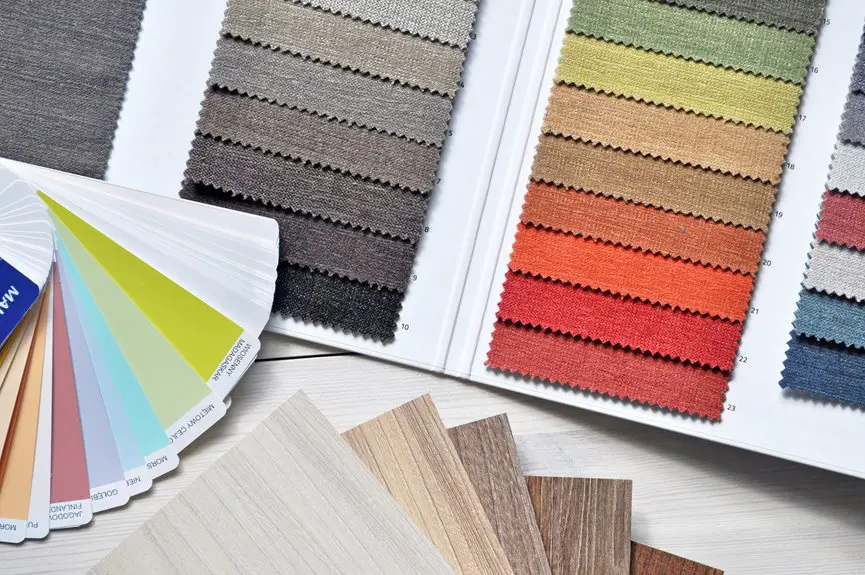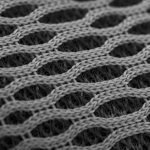Did you know that certain natural fabrics can greatly reduce static electricity? While many people focus on synthetic materials for their anti-static properties, natural fibers like cotton and wool offer effective solutions too. These fabrics not only help minimize static cling but also provide comfort and style. Curious about which specific fabrics stand out and how they work? Let’s explore the best options available.
Table of Contents
Key Takeaways
- Cotton is highly effective at absorbing moisture, significantly reducing static buildup and enhancing comfort.
- Wool’s natural insulating properties create air pockets that help dissipate static charges effectively.
- Linen offers durability and breathability, resulting in low static cling, making it ideal for warm climates.
- Hemp is strong, moisture-absorbent, and resistant to static, making it a durable choice for various applications.
- Bamboo fabrics are soft and moisture-wicking, providing excellent anti-static qualities while being eco-friendly.
Understanding Anti-Static Properties of Natural Fibers
While you mightn’t think about it often, the static electricity in fabrics can be a significant annoyance. This issue often arises from the materials you choose to wear.
Natural fibers like cotton, wool, and linen tend to absorb moisture from the air, reducing static buildup. Unlike synthetic fibers, which can trap electrons and create static shocks, these natural options provide a more balanced charge. When you wear them, you may notice less cling and fewer shocks.
Additionally, fabrics with a tighter weave can further minimize static electricity. By understanding these properties, you can make more informed choices about what you wear, ensuring comfort and reducing those pesky static surprises in your daily life.
Top Natural Fibers for Anti-Static Applications
When it comes to choosing fabrics that minimize static electricity, several natural fibers stand out for their anti-static properties.
Cotton is a top choice because it absorbs moisture and helps reduce static buildup.
Cotton effectively absorbs moisture, making it an excellent fabric for minimizing static electricity.
Linen also excels, offering breathability and low static cling, making it perfect for warm climates.
Wool, with its natural crimp, creates air pockets that help dissipate static charges.
Hemp is another excellent option, as it’s durable and absorbs moisture effectively, which helps control static.
Finally, silk provides a luxurious feel while maintaining anti-static qualities.
The Role of Moisture in Reducing Static Electricity
Moisture plays an essential role in reducing static electricity, and understanding this can help you choose the right fabrics.
Hydrophilic fibers, for example, naturally attract and retain moisture, which can greatly lessen static buildup.
Hydrophilic Fiber Properties
Hydrophilic fibers play an essential role in minimizing static electricity, as they readily absorb moisture from the environment. When you wear fabrics made from these fibers, like cotton or linen, they help maintain a balanced level of moisture against your skin.
This moisture creates a conductive layer that reduces static charge buildup, keeping you comfortable and preventing shocks.
Additionally, hydrophilic fibers can wick sweat away, which enhances your overall experience in various conditions.
You’ll find that when moisture is present, these fabrics perform much better compared to their hydrophobic counterparts.
Moisture Retention Benefits
Although many people overlook it, moisture retention plays an essential role in reducing static electricity. When fabrics hold moisture, they can help create a conductive environment that dissipates static charges.
Here’s how moisture retention benefits you:
- Better Comfort: Moist fabrics maintain humidity levels, preventing dryness that often leads to static buildup.
- Enhanced Performance: Fabrics like cotton and wool can absorb moisture, keeping you comfortable and reducing clingy static.
- Longer Lifespan: Natural fabrics with moisture retention properties tend to resist wear and maintain their integrity longer, contributing to less static over time.
Enhancing Natural Fibers With Anti-Static Treatments
When you want to enhance the performance of natural fibers, applying anti-static treatments can make a significant difference. These treatments reduce static cling, improve comfort, and extend the life of your fabrics. Depending on the treatment, you can choose methods that are eco-friendly or those that provide longer-lasting effects.
Here’s a quick comparison of some popular anti-static treatments:
| Treatment Type | Benefits |
|---|---|
| Ionic Agents | Reduces static charge |
| Coating Solutions | Creates a protective layer |
| Conductive Fibers | Enhances electrical conductivity |
| Natural Oils | Eco-friendly option |
| Anti-Static Sprays | Easy application |
Textile Manufacturing Techniques for Anti-Static Fabrics
As you explore textile manufacturing techniques for anti-static fabrics, it’s essential to understand how various processes can influence the performance of your materials.
The right techniques can greatly enhance the anti-static properties of natural fibers. Here are three key methods to evaluate:
The correct techniques can significantly improve the anti-static capabilities of natural fibers.
- Blending with Conductive Fibers: Incorporating conductive fibers like carbon or metal can help dissipate static electricity effectively.
- Specialized Weaving Techniques: Certain weaving patterns can create tighter fabric structures that minimize static build-up.
- Moisture Control: Maintaining ideal moisture levels during production can reduce static electricity, as moisture helps conduct electricity more efficiently.
Practical Applications of Anti-Static Natural Fabrics
When it comes to practical applications, anti-static natural fabrics shine in both workwear and casual settings.
You’ll find these materials enhance safety in environments like labs or electronics manufacturing while also providing comfort for everyday wear.
Whether you’re in a professional role or just running errands, these fabrics can make a noticeable difference.
Workwear and Safety
In environments where static electricity poses a risk, choosing the right workwear can make a significant difference.
Anti-static natural fabrics not only provide comfort but also enhance safety. Here are some practical applications for workwear:
- Electrical Work: Wearing anti-static fabrics helps prevent shocks and protects sensitive equipment.
- Manufacturing: These materials reduce the risk of sparks that could ignite flammable substances.
- Laboratories: In chemical and research settings, anti-static clothing minimizes contamination and guarantees a safe working environment.
Professional and Casual Use
While you might think anti-static fabrics are only for industrial settings, they’re also perfect for professional and casual wear.
Imagine slipping into a sleek anti-static cotton shirt for a meeting; it keeps you comfortable while preventing static shocks. For casual outings, anti-static linen pants can keep your look polished and practical, allowing you to move freely without the annoyance of cling.
These fabrics not only enhance your style but also protect your electronic devices from static discharge.
Whether you’re at the office or out with friends, choosing anti-static natural fabrics means you can enjoy the benefits of comfort and style without any hassle.
Make anti-static fabrics your go-to choice for both professional and casual occasions!
Future Trends in Anti-Static Fabric Development
As the demand for sustainable and functional textiles grows, innovations in anti-static fabric development are set to reshape the market.
You’ll notice a shift towards materials that combine eco-friendliness with advanced functionality. Here are some trends to watch for:
- Biodegradable fibers: Expect an increase in the use of natural fibers that not only resist static but also break down naturally after use.
- Smart textiles: Fabrics that incorporate conductive materials, allowing for anti-static properties while integrating technology like sensors.
- Enhanced treatments: Look for innovative finishes that provide long-lasting anti-static effects without compromising the fabric’s natural qualities.
These advancements won’t only improve performance but also align with your values for sustainability and environmental responsibility.
Keep an eye out for these exciting developments!
Frequently Asked Questions
Are Anti-Static Natural Fabrics Safe for Sensitive Skin?
Imagine wrapping yourself in a gentle embrace. Anti-static natural fabrics are generally safe for sensitive skin, as they’re breathable and soft. You’ll likely feel comfortable, but always test a small area first to be sure.
How Do I Care for Anti-Static Natural Fabric Clothing?
To care for anti-static natural fabric clothing, wash them gently in cold water, avoid harsh detergents, and air dry. Don’t use fabric softeners; they can reduce the anti-static properties and damage the fibers.
Can Anti-Static Natural Fabrics Be Used in Electronics?
Using anti-static natural fabrics in electronics is like using a shield against static electricity. You can protect sensitive components from damage, guaranteeing they function smoothly. Just verify the fabric’s properties align with your specific electronic needs.
What Are the Environmental Impacts of Anti-Static Treatments?
Anti-static treatments can harm the environment by releasing toxic chemicals during production and disposal. You should consider eco-friendly alternatives, as they minimize pollution and reduce harmful impacts on ecosystems while maintaining effectiveness in preventing static build-up.
How Do Anti-Static Fabrics Compare to Synthetic Alternatives?
You might think synthetic fabrics dominate anti-static properties, but natural options can surprise you. While synthetics often excel in performance, their environmental impact raises questions. You’ll find natural alternatives that balance effectiveness and sustainability, offering more than expected.
- Tetron Fabric for Marine Applications: Durability and Use Cases - June 18, 2025
- Tetron Fabric for Outdoor Furniture: Weather Resistance and Care - June 18, 2025
- Tetron Fabric for Wall Coverings: Style and Application Tips - June 18, 2025






